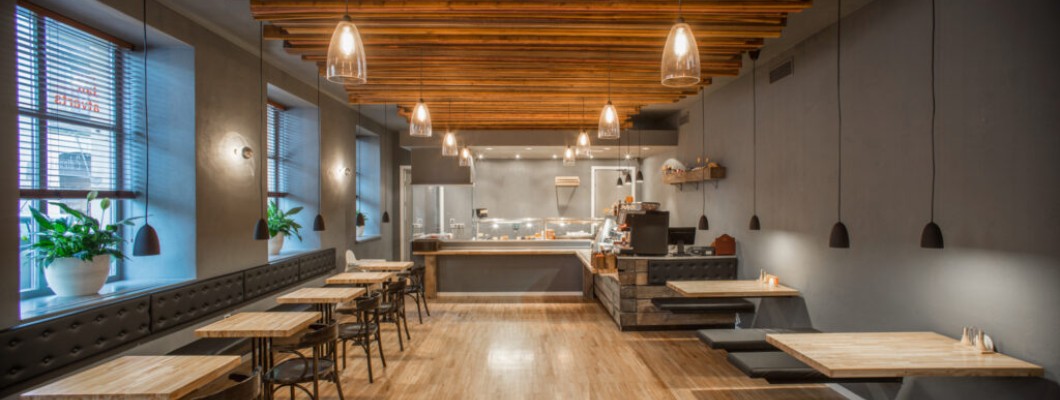
Creative Restaurant Lighting Ideas to Transform Your Dining Space
Effective restaurant lighting is not just about illuminating your space; it’s about creating experiences and elevating moods. Whether you aim to induce warmth and intimacy, or to energize and impress, the correct lighting is pivotal. This article delivers 10 distinctive restaurant lighting ideas to transform your dining arena, expertly balancing form with function.
Creating Ambience with Lighting: Crafting the Perfect Mood
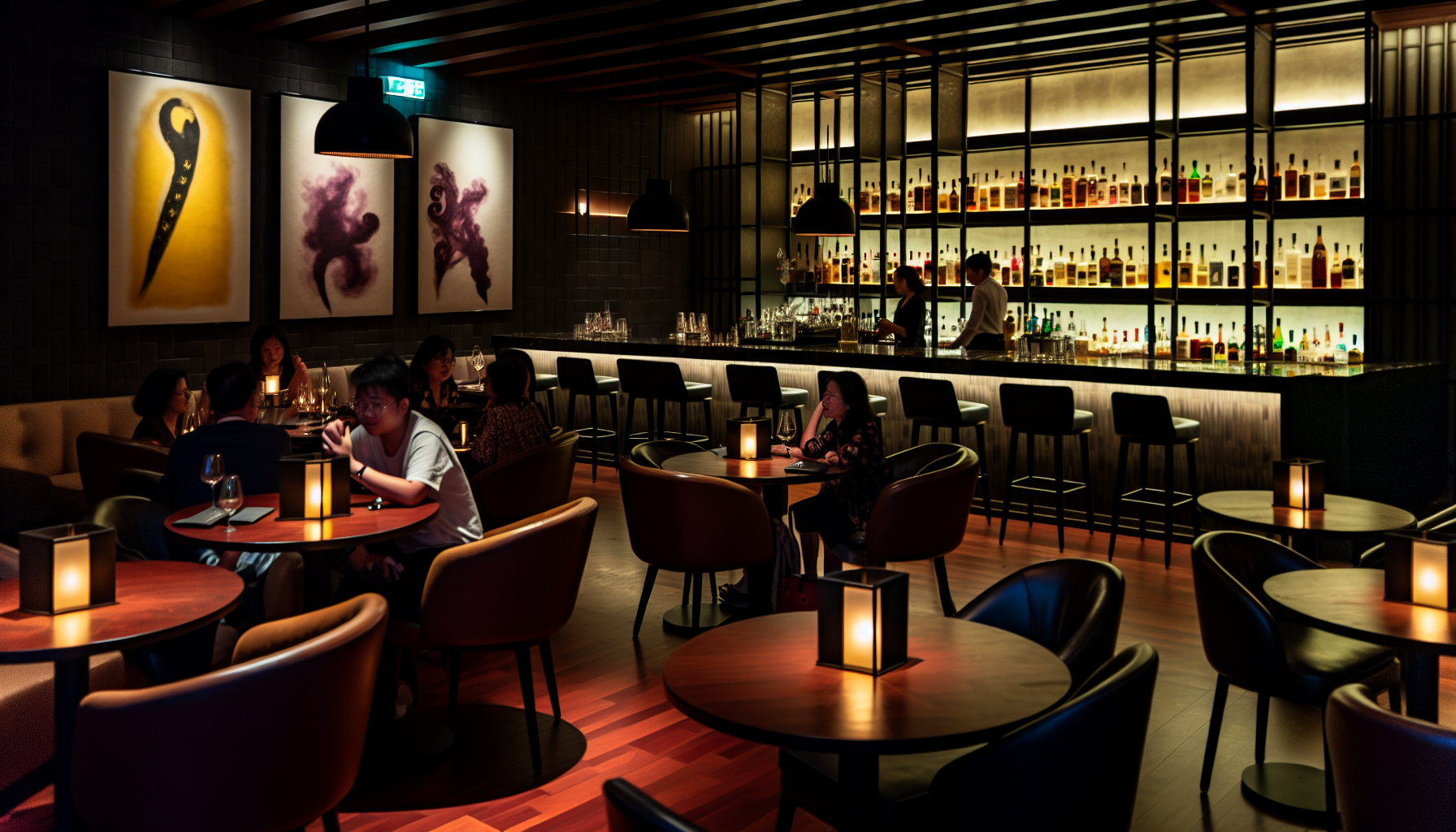
The play of light and shadow can turn an ordinary space into a haven of comfort, excitement, or intimacy. In restaurants, lighting is more than just about visibility. It’s a powerful tool that shapes diners’ experiences, influences their mood, and even sways their behavior.
From dimly lit corners ideal for romantic soirees to brightly lit spaces buzzing with energy, the right lighting sets the tone for your restaurant.
Ambient Glow
Ambient lighting sets the overall mood in a restaurant. It provides the fundamental level of illumination, ensuring that diners can see and interact with their environment comfortably. With the versatility of fixtures like ceiling-mounted lights, wall sconces, and LED strips, you can create a warm, inviting glow that enhances the dining experience.
Focused Highlights
Focused task lighting, on the other hand, provides a stark contrast to the soothing glow of ambient light. As the name suggests, task lighting targets specific areas, ensuring functional efficiency and creating a focal point in the space.
For example, the clear illumination provided by pendant lights at the kitchen island or bar enhances both functionality and aesthetics, facilitating food preparation and mixology.
Dramatic Flair with Accent Lighting
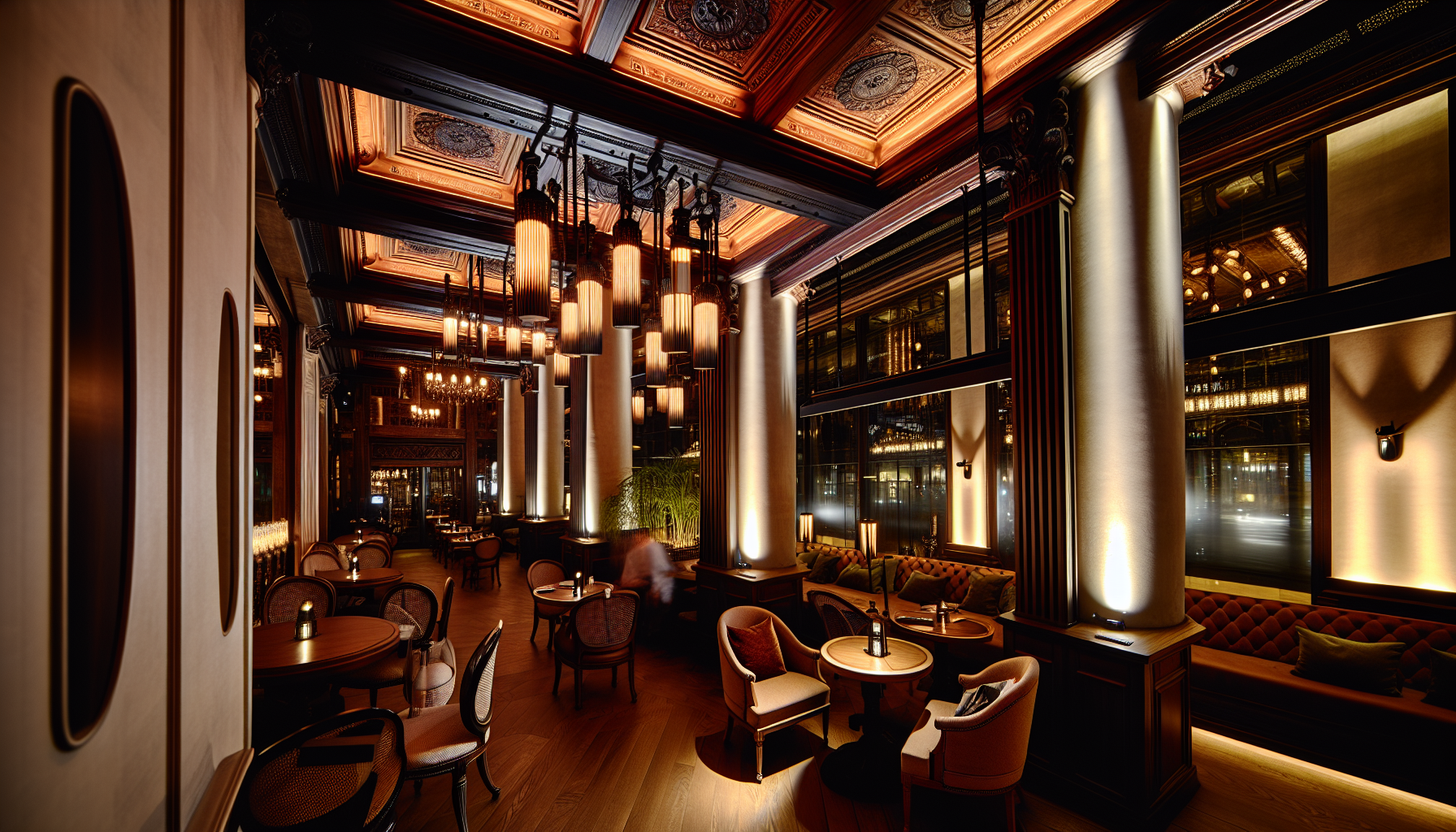
Consider accent lighting as the final brushstroke that completes your restaurant’s lighting portrait. It’s the dramatic flair that highlights the architectural details and decorative elements, bringing them center stage. Whether it’s a striking wall sconce over a fireplace or a spotlight on a piece of art, accent lighting amplifies the visual appeal of your space, adding depth and character.
Envisioning Your Space: Lighting By Restaurant Type
Lighting plays a pivotal role in narrating the unique story of every restaurant. The choice of lighting varies based on the restaurant type, each requiring a unique approach to setting the right mood. Whether it’s a fast-food joint bustling with energy or a fine-dining establishment offering an intimate experience, the lighting design must align with the restaurant’s ethos and clientele.
Casual Bites
Bright lighting is essential in fast-paced, high-energy venues like fast food restaurants or cafes. Such lighting promotes an energetic atmosphere suitable for quick dining. It also plays a significant role in facilitating a higher turnover rate - a critical aspect of these high-traffic eateries.
Upscale Elegance

In upscale restaurants, lighting assumes a dramatically different role. Here, dimmed lighting, elegant chandeliers, and pendant lights come into play, creating an intimate atmosphere and enhancing the customer experience. The ability to adjust lighting levels with dimmer switches adds to the flexibility, allowing the restaurant to set the right mood for various dining occasions.
Harnessing Natural Light
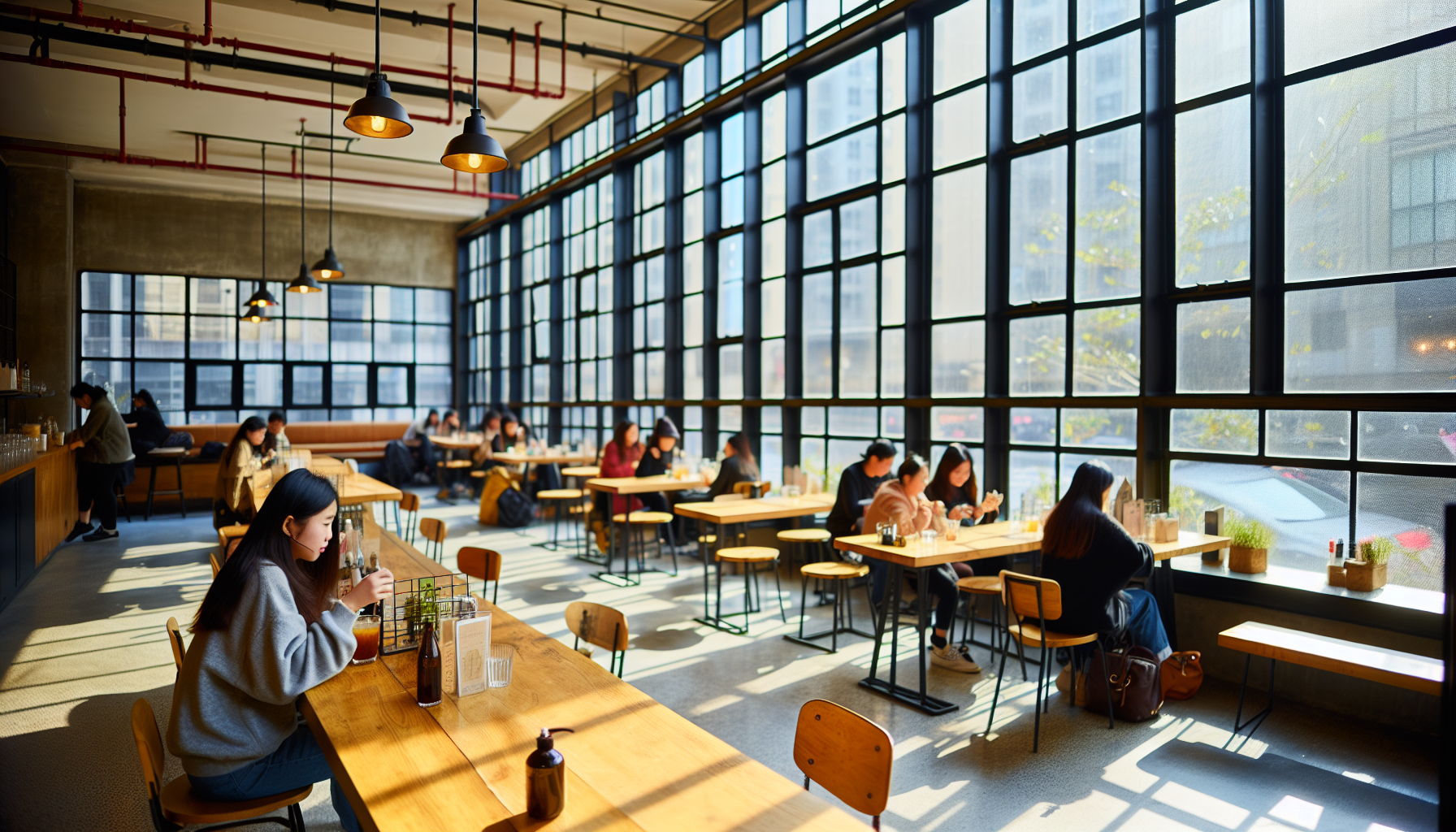
Natural light, the original artist of light and shadow, is an invaluable resource in restaurant lighting. Its warmth and brightness during the day can be harnessed to improve the restaurant’s aesthetic appeal and positively affect the dining experience.
Strategically placed windows can flood your restaurant with sunlight, creating a welcoming atmosphere that encourages customers to relax and enjoy their meal.
Window Design
Proper window placement and design can maximize the magic of natural light. By placing seating areas near windows, you can:
Maximize the utilization of natural light
Enhance the restaurant’s aesthetic appeal
Encourage a quicker customer turnover, especially beneficial during peak hours.
Managing Sunlight
Effectively managing sunlight is also part of harnessing natural light. Curtains or blinds on windows can regulate the amount of natural light entering the restaurant, maintaining a comfortable dining atmosphere. In addition, the use of impact windows can filter out harmful UV rays, prevent uneven heating from direct sunlight, and reduce glare that can disrupt the dining experience.
Outdoor Illumination Concepts
The charm of a restaurant extends beyond its interior. Exterior spaces like gardens, patios, and even the entrance play a crucial role in creating a memorable dining experience. Outdoor lighting enhances a restaurant’s curb appeal by illuminating signage and highlighting architecture, while also creating a recognizable atmosphere that entices guests during the warmer months.
Signage and Entrance
Think of a well-lit entrance as a warm handshake, welcoming guests into your restaurant. Backlit lettering for signage ensures night visibility and adds a modern touch to the entrance.
Modern wood panel designs with backlighting can attract passersby, making a strong first impression.
Patio and Garden Lights
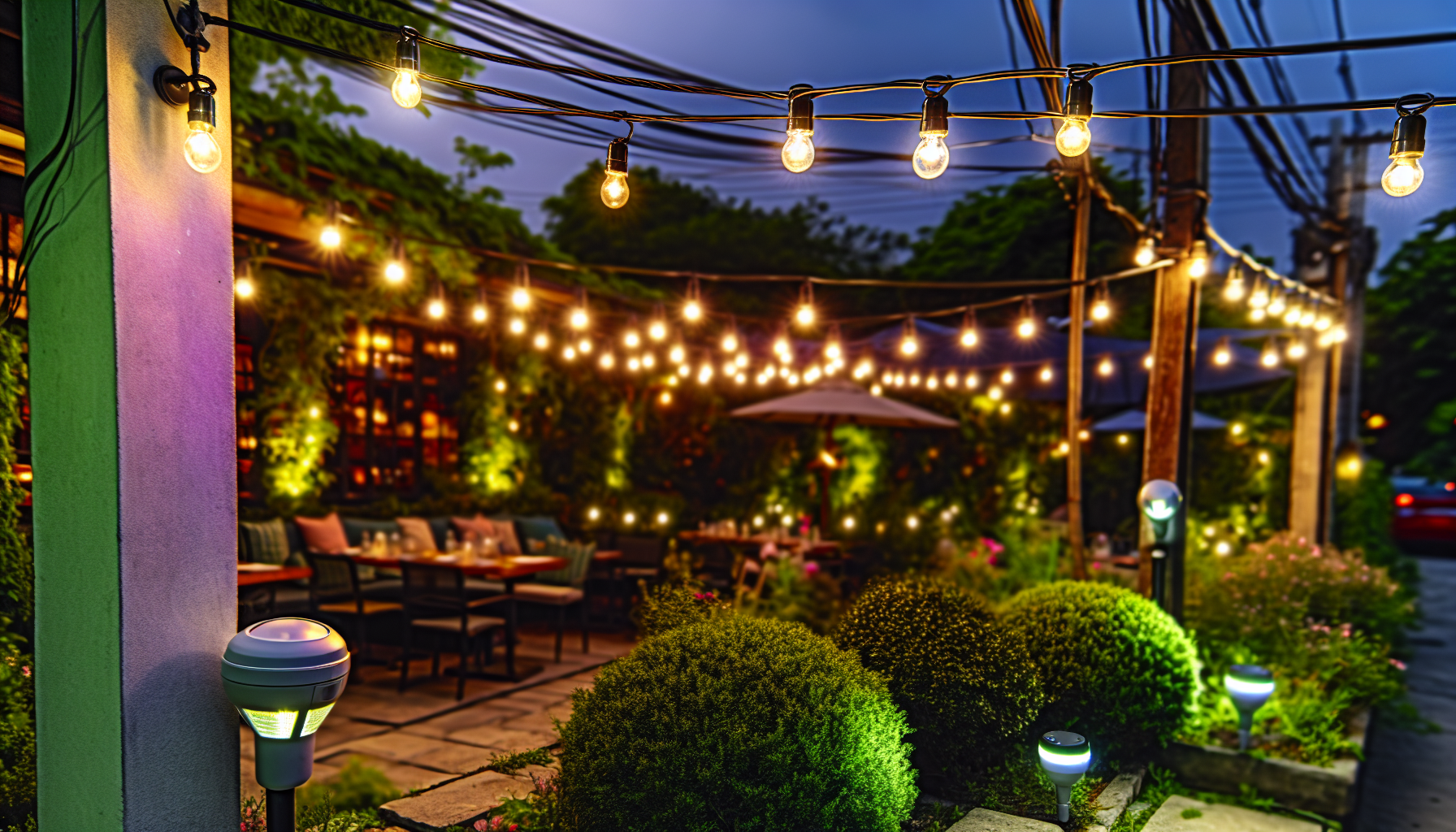
The right lighting can infuse outdoor spaces like patios and gardens with a warm and inviting atmosphere. The use of decorative lights, such as festoon lights, solar-powered path lights, waterproof LED spotlights, and led strip lights, can enhance the space’s appeal and provide unique lighting ideas with outdoor lighting fixtures.
Not just that, strategic placement of motion sensor lights can improve safety by illuminating the space upon detecting movement, adding an extra layer of security.
Innovative Smart Lighting Solutions
With the advancement of technology, restaurant lighting too, is witnessing a revolution. Innovations like smart lighting offer convenience and enhance the dining experience. These solutions can automate lighting based on activity, providing a seamless dining experience, particularly in fast-food restaurant environments.
Automated Systems
You can program automated lighting systems to alter the ambiance throughout the day or in response to changes in occupancy. This level of control offers both convenience and energy efficiency. Moreover, smart lighting systems have a longer lifespan and require minimal maintenance, leading to significant cost savings.
App Integration
Smart lighting also extends its power to smartphones. With app integration, restaurants can control lighting levels, providing the flexibility to switch lights on or off and adjust their dimness according to the desired setting.
This level of customization enhances the dining ambiance in the dining room with dynamic lighting transitions.
The Art of Menu and Vanity Lighting
Menus, being more than just a list of dishes and prices, form a vital part of a restaurant’s brand. Hence, ensuring that customers can read menus easily is crucial. Adequate menu lighting, enhanced by lighter shades of tablecloths, can significantly improve readability.
Similarly, vanity lighting in restaurant bathrooms should not only provide sufficient illumination but also contribute to a positive and bright environment.
Navigating the Spectrum: Choosing the Right Color Temperature
The mood and appearance of your restaurant can be significantly impacted by the color temperature of light. Warm light, typically in the range of 2700K to 3000K, enhances the appetizing qualities of food and stimulates appetite.
On the other hand, cool light, ranging from 4000K to 6500K, accentuates the freshness of salads and fruits and creates a modern look in dining spaces.
Eco-Friendly and Cost-Saving Lighting Options
The restaurant industry is witnessing a surge in the popularity of eco-friendly and cost-saving lighting options as the world shifts towards sustainable practices. LED and CFL bulbs are notable for being more energy-efficient compared to traditional incandescent bulbs, reducing electricity costs significantly. Additionally, they emit less heat, reducing the workload for air conditioning systems and enhancing energy savings.
From Functional to Decorative: Light Fixtures as Design Elements
Light fixtures in a restaurant fulfill a dual role - they not only provide essential dining room lighting, including recessed lighting, but also contribute significantly to the interior design. Custom light fixtures or artistic installations reinforce the dining concept and add to the customer’s experience.
The material and style of light fixtures should harmonize with the restaurant’s design, enhancing the visual appeal and thematic consistency.
Sculpting with Shadows: The Role of Contrast in Restaurant Lighting
The contrast in lighting, by adding depth and texture to a dining area, significantly influences the atmosphere and customer perception. A contrast ratio of 5:1 between accent and ambient lighting helps certain elements stand out, providing a dynamic visual experience.
Manipulating color temperatures can also introduce a feeling of warmth and relaxation, counterbalancing cooler and more sterile ambient environments.
Summary
In the world of restaurants, lighting is more than mere illumination. It’s a potent tool that shapes the dining environment, influences the mood, and even sways behavior. From the warm, inviting glow of ambient lighting to the dramatic flair of accent lighting, from the functional brightness of task lighting to the natural charm of sunlight, every aspect of lighting has a role to play. As we embrace the future, innovations like smart lighting and app integrations offer a new level of control and convenience. It’s a dance of light and shadow, a play of brightness and contrast, all working together to create a memorable dining experience.
Frequently Asked Questions
What type of lighting is best for restaurant?
LED lighting is the best option for restaurants due to its energy efficiency and minimal heat production, which helps lower operating costs and maintain comfortable kitchen temperatures.
How to design lighting for a restaurant?
To design lighting for a restaurant, follow the 10 rules for optimal illumination, apply different lights for different functions, guide customers into the room with lighting, and create the right atmosphere by using color in moderation. These steps will ensure a well-designed lighting scheme for your restaurant.
What is the recommended illuminance for a restaurant?
The recommended illuminance for a restaurant is 150 lux in cafes, bars, and restaurants, with different light levels for specific sections such as entrances, food storage, washing, and cooking areas. Aim for 100 lux at entrances, 150 lux in food storage, 300 lux in washing areas, and 500 lux in the cooking section.
How does lighting influence the mood in a restaurant?
Lighting in a restaurant sets the mood; lower lighting creates a relaxed and romantic atmosphere, while brighter lighting generates a lively vibe. Adjusting lighting can affect the overall dining experience.
What is the importance of task lighting in restaurants?
Task lighting is important in restaurants as it illuminates specific areas like the kitchen or bar, ensuring operational functionality and aesthetic appeal, ultimately enhancing the overall dining experience.
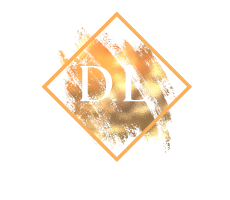
Leave a Comment